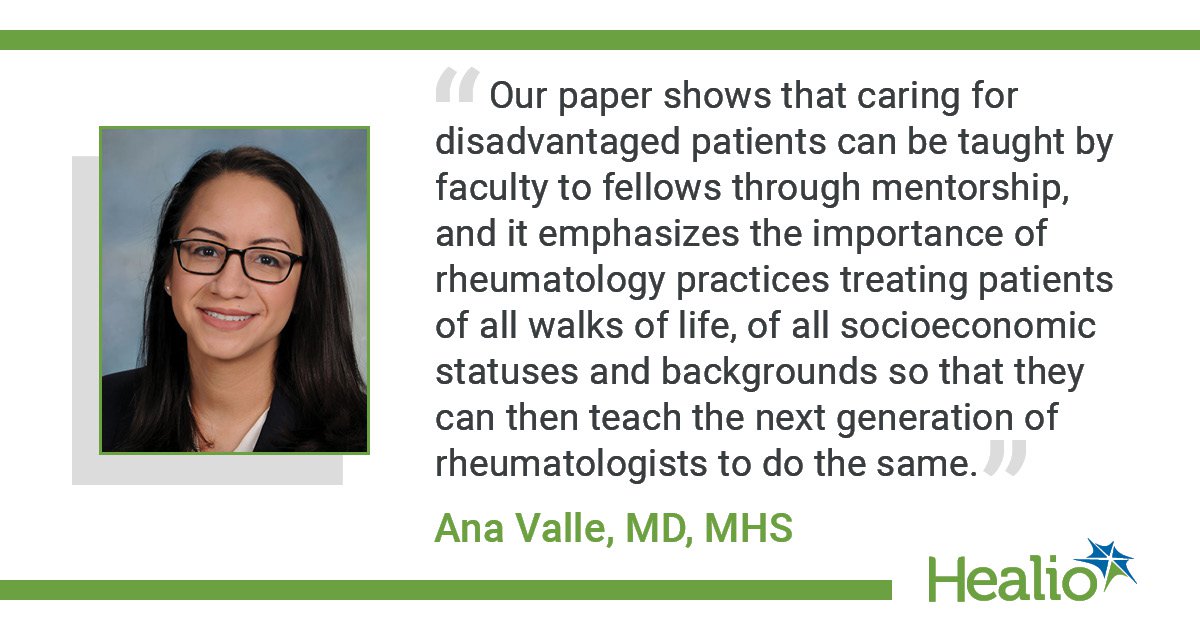Similar prescribing patterns in RA seen between fellows, faculty in hospital system
PHILADELPHIA — Prescribing patterns of fellows seeing patients with rheumatoid arthritis in an urban, academic hospital system aligned with the teaching practices of faculty, according to findings presented at ACR Convergence 2022.

“We had a retrospective study that compared DMARD, biologic and steroid prescribing patterns among nascent rheumatology cases between Bronx based faculty and fellow clinics. We wanted to know whether our faculty members teachings aligned with the fellows’ prescribing practices,” Ana Valle, MD, MHS, chief resident in internal medicine at Montefiore Health System in New York, told Healio. “That was our hypothesis and happily, we found it did.”
However, it has been demonstrated that Black and Latinx patients with RA, as well as patients of lower socioeconomic status (SES), are less likely to receive treatment with disease-modifying antirheumatic drugs. Moreover, even when DMARDs are prescribed, there tends to be delays, according to the retrospective study.
“We think this is just one of many examples where provider-level decisions can be an additional source of disparate care,” Valle said. “We want to evaluate these practices and start tackling them at the provider level, that way we can continue to improve RA outcomes in communities of color and lower socioeconomic status.”
The criteria for the retrospective chart review included incident diagnosis of seropositive RA based on ICD 9 and 10 codes input by a rheumatologist from Montefiore, documented anti-CCP of 20 U/mL or more or anti-RF of more than 12 IU/mL, available prescription data, and an address within the Bronx, New York.
The final analysis included 587 eligible patients, with 113 diagnosed in a teaching clinic and 474 diagnosed in a faculty practice. According to the abstract, fellows saw more Latinx patients (P = 0.01) as well as patients whose primary language was not English (P = 0.04). Both fellows and faculty saw patients with low SES scores, but those seen by fellows had lower scores (P = 0.05) and were less likely to hold private insurance (P = 0.002).

Patients seen by both faculty and fellows had a median time to DMARD initiation of 0 days. Similarly, the median time to initiation of a biologic was similar between groups (P = 0.49).
“The most striking finding was that the initiation of DMARDs between faculty and fellows aligned perfectly,” Valle said. “Biologic initiation was also comparable, although fellows tended to prescribe over a wide range.”
For the teaching practice, Valle and colleagues reported that steroids were prescribed for 84.1% of patients, compared with faculty who prescribed steroids for 72.8% of patients (P = 0.01). However, despite this initial difference, prescribing time of steroids was similar between the two groups. Additionally, this difference may be attributed to differences in patients’ disease activity and differences years of experience, Valle noted
“Our paper shows that caring for disadvantaged patients can be taught by faculty to fellows through mentorship, and it emphasizes the importance of rheumatology practices treating patients of all walks of life, of all socioeconomic statuses and backgrounds so that they can then teach the next generation of rheumatologists to do the same,” Valle said. “Our study shows that it is advantageous for our faculty to see all patients, regardless of their insurance or socioeconomic status, and of other backgrounds as well.”







